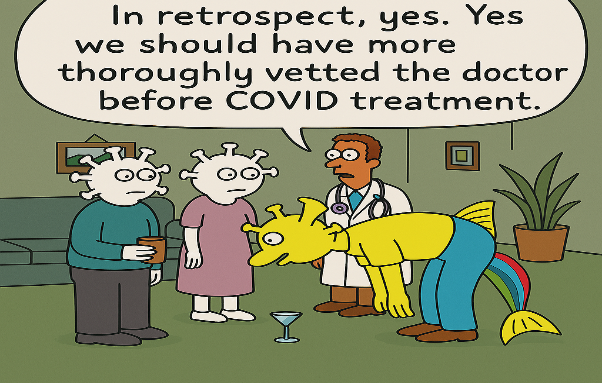By Dr. Faith Coleman, Study finds
COVID-19 has been a tangle of alarming riddles wrapped in perplexing enigmas and devastating consequences. It has killed more than a million people in the United States and seven million worldwide. The pandemic’s fallout includes many millions more with unrelenting, disabling, systemic conditions known as “long COVID.”
In the United States, research shows that about 7% of adults and 1% of children – that’s 15 to 20 million Americans – have had long COVID. It is reasonable to speculate that new cases of long COVID are developing and will continue to emerge since COVID-19 shows no sign of going away permanently. We can only hope to get better at the prevention and treatment of acute COVID infections and its long-term complications.
So, what exactly does it mean when physicians say “long COVID,” and what process do we go through when it comes to defining diseases? Let’s break down how doctors do this and why it’s important.
Knowledge in medicine is advanced through research and experience – the so-called “evidence-based” information which has become not just a descriptor but a catchphrase. From my viewpoint, medicine has always been, to a degree, evidence-based – what works, what doesn’t work.
To share and use information, whatever its means of collection, health professionals, including researchers, need to speak a common language. If one research team makes discoveries about long COVID and publishes their findings, that information is useful only if the readers have the same definition of long COVID (i.e., they are talking about the same entity).
A variety of definitions had been advanced for long COVID, but none gained wide acceptance. In recognition of this shortcoming, the Administration for Strategic Preparedness and Response and the Department of Health and Human Services assigned the National Academies of Sciences, Engineering, and Medicine the task of developing a definition for long COVID that considers the needs of patients as well as the views and understanding of experts.
Committee members reported that the process of developing a definition gave them a deeper appreciation for the reality and severity of the condition. There were no standardized guidelines for defining a disease, so they identified five criteria for such a definition:
- Accuracy and precision
- Feasibility in application
- Acceptability to affected parties
- Accessibility and understandability
- Balancing benefits and harms
The committee determined at the beginning that interaction with patients who were affected by long COVID was essential. The term “long COVID” was created by patients.
This process included the use of focus groups, a questionnaire, a public comment portal, and several public meetings, including a two-day symposium. More than 1,300 people participated in these activities, including patients and caregivers, public health and health care professionals, researchers, policy and advocacy professionals, payers, health care business professionals, and members of the public.
In this outreach, the committee members sought input from individuals who represented the full spectrum of interested and affected patients, geographic areas, and demographic groups. The detailed findings have been published in a publicly available report, What We Heard: Engagement Report on the Working Definition for Long COVID.
The Official Definition
Long COVID is an infection-associated chronic condition that occurs after SARS-CoV-2 infection and is present for at least 3 months as a continuous, relapsing and remitting, or progressive disease state that affects one or more organ systems.
Long COVID Manifests in Multiple Ways
A complete enumeration of signs, symptoms, and diagnosable conditions of long COVID would have hundreds of entries. Any organ system can be involved, and patients can present with the following:
Single or multiple symptoms, such as shortness of breath, cough, persistent fatigue, postexertional malaise, difficulty concentrating, memory changes, recurring headache, lightheadedness, fast heart rate, sleep disturbance, problems with taste or smell, bloating, constipation, and diarrhea.
Single or multiple diagnosable conditions, such as interstitial lung disease and hypoxemia, cardiovascular disease and arrhythmias, cognitive impairment, mood disorders, anxiety, migraine, stroke, blood clots, chronic kidney disease, postural orthostatic tachycardia syndrome and other forms of dysautonomia, myalgic encephalomyelitis–chronic fatigue syndrome, mast-cell activation syndrome, fibromyalgia, connective-tissue diseases, hyperlipidemia, diabetes, and autoimmune disorders such as lupus, rheumatoid arthritis, and Sjögren’s syndrome.
Important Features of Long COVID
- It can follow asymptomatic, mild, or severe SARS-CoV-2 infection. Previous infections may have been recognized or unrecognized.
- It can be continuous from the time of acute SARS-CoV-2 infection or have a delayed onset for weeks or months after what had appeared to be full recovery from acute infection.
- It can affect children and adults, regardless of health, disability, or socioeconomic status, age, sex, sexual orientation, race, ethnic group, or geographic location.
- It can worsen preexisting health conditions or present as new conditions.
- It can range from mild to severe and can resolve over a period of months or can persist for months or years.
- It can be diagnosed on clinical grounds; no biomarker that is currently available conclusively determines the presence of this condition.
- It can impair patients’ ability to work, attend school, take care of family, and care for themselves, resulting in profound emotional and physical effects on the patients, their families, and caregivers.
If you or someone you know is experiencing the symptoms or conditions described here, I hope this helps to clarify what is happening with your health or encourages you to get medical attention for your disease.
Cynicism and discontent with American health care systems seems to be at an all-time high. Many complaints are valid. Healthcare will never be a finished product. I would like you to take from reading this, however, that it was a patient-driven process. There are countless compassionate, caring, brilliant people, in many fields, working hard to advance health care. Their only motivation and goal are bettering the lives of those they serve — you, the public.
